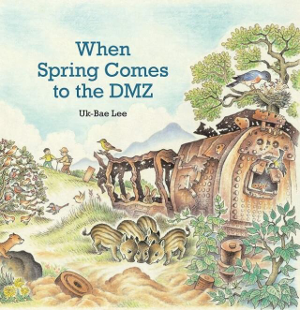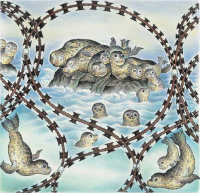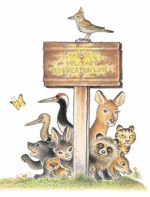Book Review: When Spring Comes to the DMZ
When Spring Comes to the DMZ is a good introduction to the challenges that North Korea and South Korea still face as the result of a war that ended more than 60 years ago. The book illustrates the author's overall mission of spreading the call for peace. 
The book, written and illustrated by Uk-Bae Lee, was published in 2010 as part of the Peace Picture Book Project, involving author and illustrators from China, Japan, and Korea. Lee, a native of Yongin, South Korea, studied art at Hongik University and has made a living as an artist and illustrator, often teaching free painting classes for factory workers. His first picture book, Sori's Harvest Moon Day, arrived in English in 1999. Another of his books, the 2010 publication A Tale of Tales, made the IBBY Honour List of the International Board on Books for Young People. When Spring Comes to the DMZ was published in Lee's native language in 2010 and is now out in English. 
The book puts a softer sheen on what is otherwise a place of horrors, the Demilitarized Zone, or DMZ, a 2.5-mile-wide, 150-mile-long no-man's-land that divides North Korea and South Korea and is the product of the war between the two countries, which raged from 1950 to 1953, injuring or killing millions of people and displacing millions more. Military exercises still take place on both sides of the area, and one of those punctuates the otherwise tranquil nature of the book, which is essentially a set of interactions between a young boy and his grandfather. The grandfather returns to the DMZ each season, hoping that his latest visit will reveal a way for him to return to his long-lost friends, who live on the other side. What he finds instead is miles of razor wire and locked gates–a definite deterrent to travel at all, let alone reconciliation. And yet, the razor wire and the other remnants of the deadly war are not the focus of the book, of either the words or the pictures (both done by Lee himself). Rather, the boy and his grandfather see the animals that live there and the seasons that pass and how Nature finds a way even in the most desolate of places. The animals coexist (and so, the author seems to suggest, why can't we?). 
The animals, in their strongly realized imagery, represent the kind of togetherness that people cannot have, at least as long as the artificial barriers remain. In spring, as the title of the book references, a family of seals swims up a river that divides the two countries. People cannot cross the river, the grandfather says, "But the seals come and go freely." Other animals echo this experience in summer. Birds build nests and increase their families, and deer and otters play in the river–all within the same area, all without incident. Autumn is the setting for a trip by salmon, returning to their birthplace to spawn. Birds arrive in winter. Things go on as they have for a great many years, despite the presence of such man-made devastation. 
Juxtaposing each season's depiction of animals' rebirth and renewal is an illustration of the fencing and razor wire and the soldiers who police the area. The book does not present any of these scenes in a pro-military way–quite the opposite, actually. The grandfather, in his own patient way, longs for the end of the division and returns each season in the hopes that he will one day see it as a reality. (The author provides a hint of what this could look like in a world map at the very back of the book.) Because the DMZ is a no-go zone for people, the land has become a wildlife sanctuary, even encouraging the proliferation of some endangered species. The author chooses to illustrate and write about this as a concept, showing the animals enjoying the landscape and the richness of the river and the land. In a postscript, Lee argues that the DMZ should disappear but that the wildlife refuge should remain (surely anticipating the kind of danger of a renewed human presence in what is now such a tranquil, vibrant environment). The overriding message of the book is peace. Lee has made it his mission to talk to groups of children (and adults) about how they can work for peace. The author himself answered a few questions about the book.
Q: What would you like readers to take away from your book? Is this a call for action?
This book is available from Amazon, from Barnes and Noble, and from other booksellers, particularly those of the bricks-and-mortar variety. |
|
Social Studies for Kids
copyright 2002–2024
David White




